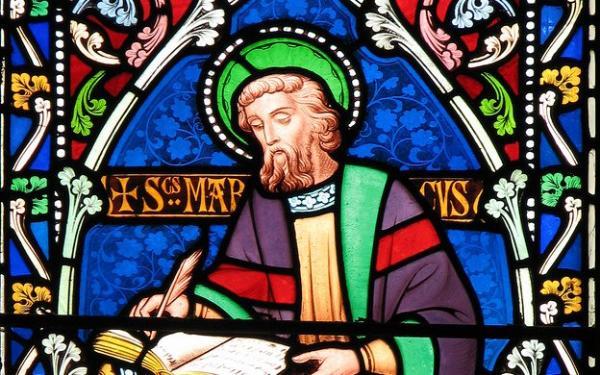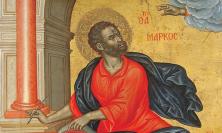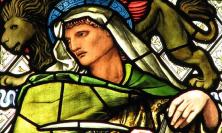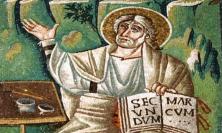The beginning of Advent marked the start of a new liturgical year for the Church. We are now in Year B and our guide for most of the Sunday readings will be Mark. Peter Edmonds SJ traces the path through Mark’s Gospel that we will follow over the coming year – what will we hear when we listen attentively to the voice of Saint Mark?
On 3 December 2017, the Church begins a new liturgical year by celebrating the start of Advent. At the same time, we began to hear a new voice in our Sunday gospels. After a year during which we have regularly listened to Matthew on Sundays, we now attend to Mark. This might seem to be a simple change. But like many things in life, what at first sight seems straightforward is not all that easy in practice. In this short treatment, we want to consider some typical difficulties that those responsible for the shape of the cycle of readings had to overcome and to indicate some of the solutions that they adopted.
A first problem concerns all the Sunday gospels. We have four canonical gospels. The longest is Luke with 1149 verses and the shortest is Mark with 662. Each of these introduces and tells the story of Jesus in its own way. Luke’s narrative is very complete; it comes with a long infancy story and relates a series of resurrection appearances of Jesus. Mark in contrast gives no information about the infancy of Jesus and, in its probable original form, merely anticipates a resurrection appearance. The Lectionary cycle lasts for three years; how are four gospels to be incorporated into a three-year cycle? What sort of selection from this material will do justice to it? And what is to be done about the many repetitions that arise because the various gospels treat similar material?
A second problem is that the liturgical year does not correspond to the gospel story. Roughly speaking, the gospels tell of the infancy and birth of Jesus, his mission in Galilee, his journey to Jerusalem, and his final ministry and death in that city. The liturgical year commences with Advent and Christmas, a period which extends over six Sundays; after an interval of around five weeks, it moves into Lent and the Easter season, concluding with Pentecost, a period of about 13 weeks. Then there is a long stretch of up to 29 Sundays known as ‘Sundays of Ordinary Time’. The gospel narratives have to be adapted to fit into this schema. Let us see how this has been done with the Gospel of Mark.
Advent and Christmas (Mark 13:33-37; 1:1-8, 6-11)
Advent is preparation for the coming of the Word of God into our world at Christmas. Christian life does not just look to the past; it also focuses on the future, as Paul remarks in Philippians, ‘forgetting what lies behind and straining forward to what lies ahead’ (Philippians 3:14). So our first reading from Mark on the first Sunday of Advent comes from his great discourse of Jesus at the end of his ministry. He speaks in imperatives to his disciples: ‘Beware, keep alert, keep awake’ (Mark 13:33). These words set the mood not just for the season of Advent, but for the whole Christian year. They continue the atmosphere set by the final gospel readings from Matthew which concluded the year just finished.
On the second Sunday of Advent, we hear the opening verses of Mark (1:1-8). These fulfil the same role for Mark that the infancy stories did for Matthew and Luke in their gospels. They give us information that we need for understanding the story of Jesus that is to follow. The first verse gives us the identity of Jesus; he is Christ and Son of God. In Mark’s story, we have to wait eight chapters for a human being (Peter) to call Jesus ‘the Christ’ (8:29) and fifteen chapters for another, a Roman soldier, to call him ‘Son of God’ (15:39). Then scripture is quoted: not just Isaiah (40:3), but Exodus (23:20) and Malachi (3:1) too. This coming of Jesus is a continuation and completion of God’s work in the past. This is reinforced by the work and words of John the Baptist. His diet and dress put him in the line of the prophets of old (2 Kings 1:8). His words inform us that the Jesus who is to come, is ‘the Stronger one’, the one who will ‘enter the strong man’s house’ and tie him up (Mark 3:27). With all this in mind, we are ready for the message and events of Christmas.
We will not hear Mark again until the Feast of the Baptism of Jesus after Christmas. Then we listen to the voice of God, the principal though unseen actor in the Gospel of Mark, telling Jesus that he is his ‘Son, the Beloved’, a further scriptural quotation which echoes Isaiah’s words about the servant of the Lord (Isaiah 42:1) and words of Genesis about Isaac, the son of Abraham (Genesis 22:2). If we want to celebrate Christmas with the mind of Mark, then we make our own the message of these first eleven verses of his gospel. They are the foundation on which the rest of Mark’s Gospel is built.
Sundays in Ordinary Time Before Lent [3B-6B] (Mark 1:14-1:45)
Over the four Sundays which occur before the Lent of 2018 begins, we have an uninterrupted reading from Mark which begins with Jesus’s call of the first four disciples and concludes with his cure of a leper (1:41-45).
These verses are important. Firstly, they provide us with the first public words of Jesus in this gospel. These call for repentance and for belief in the gospel (1:15). In all that happens from now on, we may ask how far this call is being heeded. Secondly, we note that the public action of Jesus is to call disciples. His authority is such that those called immediately leave home, family and employment to follow Jesus. This indicates how radical and demanding the gospel is. Jesus will never be alone in this gospel. Thirdly, we see how the ministry begins. Jesus is at work in town and synagogue, in house and desert. The demons are subject to him; he cures diseases, even leprosy, he forgives sins. His ministry is to all, even the mother-in-law of Simon. And yet, when at the end of this ‘day in Capernaum’, Jesus goes out at dawn to pray, his disciples interrupt him. Already the tension is building. Who is repenting and believing in the gospel, the reader may well ask. But now we have to break off the story because Lent is beginning.
Lent and Easter (Mark 1:12-15; 9:2-10; 11:1-10; 14:1-15:47)
The choice of readings during Lent owes much to tradition. The first Sunday is always concerned with the Temptations of Jesus and the second with his Transfiguration. On Passion (or Palm) Sunday, at the beginning of Holy Week, we hear the long story of the Passion. It is Mark’s version of Jesus’s Temptation, Transfiguration and Passion which we hear this year. Let us put to one side the voices of other evangelists which may be more familiar to us.
Mark’s version of the Temptation of Jesus is the shortest of the gospel accounts. It is a continuation of the baptism story. Brief though it is (and we are tempted to embellish it with details from Matthew and Luke), it has echoes of the temptations of Israel in the desert (Psalm 95:8), of Isaiah’s prophecy of the lion lying with the calf (11:6), of Adam being fed by the angels, as old rabbinic tradition related. It warns the reader to expect conflict. Satan will reappear in the account to come not only in his own person, but as one who manipulates the religious authorities of the time and even Jesus’s own disciples (8:33). This conflict of Jesus with Satan will meet its climax in the passion story when Satan will appear to be the victor. ‘He himself was tempted by what he suffered’, we read in the Letter to the Hebrews (2:18).
Mark situates his narrative of the Transfiguration straight after Jesus’s warning to his disciples that he would suffer and die in Jerusalem. This vision of glory was to show his disciples that his destiny also included resurrection and future glory. Perhaps because of the Transfiguration, Mark felt no need to include resurrection appearances of Jesus in his gospel. The Transfiguration prefigures the resurrection and is a necessary supplement to the story of the Temptation. Christian life is a promise of glory as well as a warning about conflict.
Mark’s account of the Passion of Jesus is the bleakest of the four accounts that we have. By his silent endurance, Jesus plays the part of the suffering servant of Isaiah (Isaiah 52:13-53:12). Deserted by his disciples, condemned by religious and secular authorities, he dies quite alone, with a scream of desolation. Only after his death does the prayer he prayed to his Father in Gethsemane receive an answer when the veil of the temple is torn and the Roman centurion, the man in charge of his execution, cries out that he was truly the Son of God.
Lent is a good time for a prayerful reading of Mark’s account of the death of Jesus. He told it in this way so as to give hope and encouragement to suffering Christians such as those in Rome. It can do the same to those who share such tribulations in our own day. Jesus’s suffering and death completes what we have learnt about his temptation and transfiguration at the beginning of Lent.
Sundays in Ordinary Time after Easter [10B-16B; 22B-33B]
The time after Pentecost (so-called ‘Ordinary Time of the Year’) resumes our reading of Mark, though the readings for the 8th and 9th Sundays are replaced this year by the Feasts of Trinity and Corpus Christi. This year it is Mark’s version of the Last Supper that is read on the latter day (14:12-16, 22-26). This period in our reading of Mark falls into two parts, because the designers of the Lectionary decided that John’s account of the feeding of the 5000 should take the place of Mark’s, and, because this is followed in John’s Gospel by a long discourse of Jesus on the topic of ‘The Bread of Life’ (John 6:1-69), this meant that the voice of Mark becomes silent over the next five Sundays. Hence we divide this period into two parts.
Ordinary Time until Sunday 16B (Mark 4:26-6:34)
Our readings from Mark now become ‘semi-continuous’; that is a selection has been made for us. We learn how Jesus’s relatives came in search of him and and how scribes from Jerusalem accused him of being in league with ‘the prince of demons’ (3:20-35). This year, because we celebrate the Feast of the Birthday of John the Baptist on the 11th Sunday, we hear nothing from Mark’s 'parable' chapter (4:1-34). However, we did hear Matthew’s version of it in full last year (Matthew 13:1-52). Mark now offers us a series of four ‘mighty deeds’ of Jesus: he calms a storm (4:35-41), brings back to sanity a man possessed by a legion of demons (5:1-20), heals by touch a woman sick for twelve years and raises to life a dead, twelve-year-old girl (5:21-43). The second of these is never read on Sundays from any gospel. After such displays of the power of Jesus, his inability to do miracles in Nazareth is indeed striking. Mark writes, ‘He could do no deed of power there. He was amazed at their unbelief’. Jesus then sends his chosen Twelve (3:14) out on mission in pairs and on their return Jesus invites them to a deserted place to rest awhile.
At this point we leave Mark and move over to John for five weeks (John 6:1-69). Mark tells us nothing of what the Twelve experienced. Instead he gives one of the most dramatic narratives of his gospel, the story of the death of John the Baptist, but this is omitted in our series of readings (6:14-29). This reminds us to return to our own copy of Mark and to read the whole narrative between 2:12 and 6:55. Mark’s is a great story and we do not want to miss out on any of it.
Ordinary Time after Sunday 22B (Mark 7:1-13:32)
When we next hear Mark on Sunday 22B, he is reporting Jesus’s teaching about the clean and the unclean (7:1-8, 14-15, 21-23) and the following Sunday (23B), Jesus is healing a deaf and dumb man. We miss Mark’s account of the healing of the daughter of the Syro-Phoenician woman (7:24-30), because we heard Matthew’s version last year. We also miss his narrative of the second multiplication of the loaves (8:1-10), perhaps because we have heard so much about the Bread of Life from John. The story of the disciples in the boat and the cure of the blind man of Bethsaida, the one who saw men like trees walking, are also left out (8:14-26). But we do hear the climax of the ministry of Jesus in Galilee when he asks his disciples who they believe him to be, and Peter answers that he is the Christ.
At this point, the journey to Jerusalem begins. Jesus predicts his passion and explains how if anyone wants to be his disciple, that person must carry the cross. The disciples misunderstand and resist such teaching (9:30-37). Jesus instructs and warns them against scandal (9:38-43, 45, 47-48). The evangelist includes Jesus’ teaching about divorce and wealth in this section (10:2-30). James and John make requests unworthy of disciples (10:35-45). The only one who shows enthusiasm in his following of Jesus is Bartimaeus. Three times he asked Jesus for sight, and having persevered in his petition, his prayer was answered and he followed Jesus on the way that led to Jerusalem and death.
The third part of Mark’s gospel informs us about what happened when Jesus arrived in Jerusalem. On Palm (Passion) Sunday, we heard Mark’s account of the entry of Jesus into Jerusalem, and in the same liturgy, his passion account in full (11:1-10; 14:1-15:47). Otherwise we may be disappointed at how little the readings tell us about the final days of Jesus in Jerusalem. Maybe we have just run out of space; only three Sundays remain. On the 31st Sunday, we hear the story about the scribe who asked about the greatest commandment (12:28-34). On the 32nd Sunday, we are challenged by the account of the widow who put all she had into the temple treasury (12:38-44), but the narratives about the cursing of the fig tree, the cleansing of the temple and the fierce controversies of Jesus with the authorities that followed, are all omitted (11:12-27). Our final reading from Mark is an extract from the long final discourse of Jesus about the end times (13:24-32). We will hear more about this from Luke next year. But then we return to where we began on the first Sunday of Advent. The reading for that Sunday was a continuation of the final Mark reading for the year.
Conclusion
This confirms an important truth about Mark: this gospel never really finishes. Its first verse tells us that it is ‘the beginning of the gospel of Jesus’. The story of the gospel continues until the end of time. The gospel probably ended with the fear of the women who had been told to ‘go, tell his disciples and Peter that he is going ahead of you to Galilee’ (16:7). The women fled, because they were afraid. But they must have overcome their fear, and fear can be the beginning of faith, as it was for the frightened disciples in the boat (4:40). We too are invited to go to Galilee where the mission of Jesus first began and where it continued after Easter after the meeting of the risen Lord with Peter.
So it is time for us to read this text again, and notice how often in it we find the words about raising and resurrection, from the ‘lifting up’ by Jesus of Simon’s mother-in-law to the ‘has been raised’ message of the young man to the women in its final chapter (1:31; 16:6). Mark’s Gospel is not just a warning about the cost of discipleship; it is a promise about its rewards. ‘Those who lose their life for my sake and for the sake of the gospel, will save it’ (8:35). We have much to learn from Mark this coming year, and still more when this gospel comes round again on Sundays three years from now.
Peter Edmonds SJ is a member of the Mount Street Jesuit community.
Editor’s note: This article was amended in December 2014 and again in November 2017 to account for differences between the liturgical years beginning in Advent 2011 (for which this article was written), Advent 2014 and Advent 2017.
See also:
‘Saint Mark the Pastor’ by Peter Edmonds SJ on Thinking Faith






